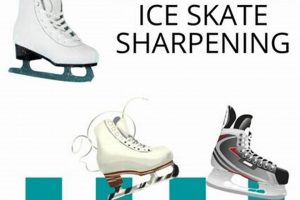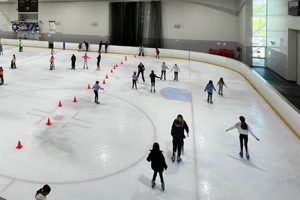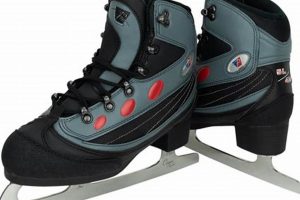The activity involves propelling oneself across a frozen water surface using specialized footwear equipped with blades. This process requires balance, coordination, and the application of controlled movements to achieve forward motion and maintain stability. Mastering the fundamentals of this skill allows individuals to engage in recreational and competitive pursuits on frozen surfaces.
Proficiency in this skill offers various physical and mental advantages. It enhances cardiovascular fitness, strengthens lower body muscles, and improves balance and coordination. Historically, it has served practical purposes such as transportation on frozen waterways, evolving into a popular recreational activity and competitive sport that fosters both individual skill development and community engagement.
The following sections will provide a detailed explanation of the essential techniques, equipment considerations, and safety precautions necessary for successfully navigating frozen surfaces on blades. This information is designed to facilitate a gradual progression from basic maneuvers to more advanced skills, ensuring a safe and enjoyable experience.
Essential Techniques for Gliding on Ice
The following guidelines provide a structured approach to developing proficiency. Adherence to these principles will enhance balance, control, and overall safety.
Tip 1: Maintain Proper Posture. A slight bend at the knees and a forward lean at the hips promotes stability and allows for efficient transfer of weight. Avoid standing rigidly upright, as this increases the risk of falls.
Tip 2: Master the Basic Stride. Initiate movement by pushing off with one skate while gliding on the other. Focus on controlled pushes and smooth transitions between strides. Gradual practice builds muscle memory and improves efficiency.
Tip 3: Practice Falling Safely. Learning to fall correctly minimizes the risk of injury. Relax the body and aim to fall to the side, avoiding outstretched arms. Protective gear, such as wrist guards, is recommended for beginners.
Tip 4: Develop Edge Control. Understanding how to use the inside and outside edges of the blades is crucial for turning and maneuvering. Practice shifting weight onto different edges to control direction and speed.
Tip 5: Implement the “Snowplow” Stop. This fundamental stopping technique involves angling both skates inward, forming a “V” shape. Apply pressure to the inside edges to slow down and come to a controlled stop.
Tip 6: Improve Balance Through Drills. Regular balance exercises, such as one-legged glides and controlled turns, enhance stability and coordination. These drills build the necessary core strength and proprioception for advanced maneuvers.
Consistent practice and mindful attention to these techniques will facilitate a safe and enjoyable experience, laying the foundation for more advanced skills.
The subsequent section will address equipment selection and maintenance, further ensuring a positive and secure experience on frozen surfaces.
1. Balance
Balance is a foundational element of ice skating proficiency. The inherent instability of gliding on narrow blades necessitates constant adjustments to maintain equilibrium. A disruption to balance often precedes falls, highlighting the direct cause-and-effect relationship between balance and safe navigation on ice. The ability to maintain an upright posture and control one’s center of gravity directly impacts the ability to execute skating techniques effectively.
Consider the act of performing a simple forward glide. Any slight shift in weight, unintended movement, or uneven ice surface can disrupt balance. Skaters compensate by subtly adjusting their body positioning, flexing their knees, and engaging core muscles. Competitive disciplines, such as figure skating, further illustrate the importance of balance. A figure skater executing a spin or jump relies entirely on precise balance control to maintain form and avoid a fall. In hockey, balance allows a player to absorb contact while maintaining possession of the puck.
In summary, balance constitutes a non-negotiable prerequisite for all ice skating activities. The challenge for novices involves developing the necessary muscle memory and proprioception to react instinctively to destabilizing forces. The practical significance of understanding and cultivating balance lies in improved performance, reduced risk of injury, and increased enjoyment of the activity. Without adequate balance, progression to more advanced skating techniques remains impossible.
2. Edging
Edging, the controlled application of pressure to the inner or outer edge of a skate blade, constitutes a fundamental mechanism for manipulating direction, speed, and stability on ice. The interaction between the blade’s edge and the ice surface generates the necessary force for turning, stopping, and maintaining balance. Without deliberate edge control, the ability to execute even basic maneuvers becomes severely limited. An individual attempting to skate without engaging the edges will experience uncontrolled sliding and an inability to maintain a consistent trajectory.
Consider the specific action of turning. A skater initiating a left turn will lean slightly to the left, placing greater pressure on the inside edge of the left skate or the outside edge of the right skate. This asymmetrical pressure creates a lateral force that causes the skater to curve along a circular path. The sharpness of the turn is directly proportional to the degree of edge engagement; a sharper angle of the blade relative to the ice results in a tighter turn radius. In contrast, attempting to turn without effectively engaging an edge leads to a wide, unstable turn or a loss of control. Hockey players rely heavily on edge control for quick turns, stops, and changes of direction, illustrating its critical role in competitive skating contexts. Similarly, figure skaters use edges to perform intricate patterns and maintain precise control during jumps and spins.
Effective edge control directly translates to improved performance, enhanced safety, and increased enjoyment on the ice. The ability to precisely manipulate edges allows for greater maneuverability, facilitating advanced skating techniques. Understanding the physics of edge engagement and practicing deliberate control of the blade’s angle are essential for any individual seeking to develop proficiency in navigating on ice. Conversely, neglecting the development of edge control limits the skater’s capabilities and increases the risk of falls and injuries.
3. Stride
The stride, a repetitive sequence of movements that propels a skater across the ice, represents a foundational element of locomotion. Efficient execution of the stride directly influences speed, endurance, and overall skating performance. Comprehending the mechanics and nuances of the stride is essential for anyone seeking to develop proficiency in ice skating.
- Leg Extension and Push-off
The propulsive force of the stride originates from the controlled extension of one leg, pushing against the ice with the blade. The efficiency of this push-off dictates the distance and speed gained with each stride. An insufficient push-off results in reduced momentum and increased energy expenditure. Elite skaters demonstrate a complete leg extension, maximizing the force applied to the ice.
- Glide Phase and Balance
Following the push-off, the skater enters a glide phase on the opposite skate. Maintaining balance and minimizing friction during this glide phase is crucial for conserving momentum. Proper posture, core engagement, and edge control contribute to a stable and efficient glide. Instability during the glide phase necessitates corrective adjustments, diverting energy from propulsion.
- Recovery and Leg Return
The recovery phase involves bringing the leg that executed the push-off back to a position ready for the next stride. A smooth and controlled leg return minimizes disruption to the skater’s balance and allows for a quick transition to the subsequent push-off. An inefficient leg return can create unnecessary drag and reduce overall stride frequency.
- Coordination and Rhythm
Effective skating relies on the coordinated integration of leg extension, glide, and recovery. Establishing a consistent rhythm and timing between these phases optimizes propulsion and minimizes wasted energy. Disrupted coordination results in an erratic and inefficient skating style. Experienced skaters demonstrate a fluid and rhythmic stride, indicative of well-developed neuromuscular coordination.
The interconnectedness of leg extension, glide phase, recovery, and coordination underscores the complexity of an efficient stride. Mastering these components allows skaters to convert muscular effort into linear motion with greater economy. Neglecting any single element compromises overall skating performance, highlighting the importance of a holistic approach to stride development.
4. Stopping
Decelerating or halting movement on ice, a crucial skill, directly influences safety and control. Without reliable stopping techniques, navigation becomes hazardous, rendering advanced maneuvers impossible. Mastering these techniques is essential for safe and effective participation.
- The Snowplow Stop: A Foundational Technique
The snowplow stop, a fundamental method, involves angling both skates inward to create a “V” shape, using the inside edges to generate friction. This technique serves as an introductory skill, allowing beginners to develop basic control over their momentum. Inability to execute this stop effectively compromises safety, particularly in crowded environments or when encountering unexpected obstacles. This method demonstrates a direct application of edge control and balance for deceleration.
- The T-Stop: Utilizing Edge Control for Linear Deceleration
The T-stop involves positioning one skate behind the other, perpendicular to the direction of travel, using the inside edge of the trailing skate to create friction. This technique requires greater skill and balance than the snowplow stop, offering more effective linear deceleration. Hockey players and figure skaters frequently employ the T-stop for controlled stops during transitions and routines. Mastering the T-stop demonstrates a refined understanding of edge control and weight distribution.
- Hockey Stop: A Dynamic and Advanced Maneuver
The hockey stop, a dynamic technique, involves turning the skates perpendicular to the direction of motion and using both edges to rapidly decelerate. This maneuver requires significant skill and coordination, often used in hockey for quick changes in direction and defensive maneuvers. Successful execution of a hockey stop depends on precise timing, balance, and edge control. Its use in high-speed situations underscores its importance for advanced skaters.
- Emergency Stopping: Prioritizing Safety in Unexpected Situations
Emergency stopping encompasses various techniques used in urgent situations to avoid collisions or hazards. These techniques may involve a combination of the snowplow, T-stop, or even intentional falls to minimize the risk of injury. Effective emergency stopping relies on quick reaction time, adaptability, and a clear understanding of the limitations of each technique. In all cases, prioritize safety of self and others.
The progression from basic techniques like the snowplow to advanced maneuvers such as the hockey stop reflects a gradual development of skill, balance, and edge control. Competent skaters utilize a combination of these techniques, adapting their approach to suit the specific situation and environment. Mastering stopping, therefore, becomes integral to the comprehensive development of skating proficiency, reinforcing safety and control for recreational and competitive purposes.
5. Posture
The alignment of the body while on ice, directly influences stability, efficiency, and injury prevention. Posture serves as the fundamental framework upon which all skating movements are built; therefore, proper posture is inextricably linked to the ability to glide effectively and safely. Deviations from optimal postural alignment compromise balance, increase energy expenditure, and elevate the risk of falls and injuries. For example, a skater with a hunched back and rounded shoulders will experience a shifted center of gravity, making it more difficult to maintain balance and execute turns with precision.
Consider the mechanics of a forward stride. A skater with a slight forward lean from the ankles, maintaining a straight back and engaged core, can efficiently transfer weight from one skate to the other, maximizing the propulsive force of each stride. This postural alignment allows for optimal engagement of the gluteal and quadriceps muscles, facilitating powerful and controlled movements. Conversely, a skater who stands rigidly upright or leans too far back will struggle to maintain balance, hindering the ability to generate power and control the direction of movement. In figure skating, postural control is critical for executing complex jumps and spins, where even minor deviations from optimal alignment can result in a failed maneuver and a potential fall.
In summary, understanding the interconnectedness between postural alignment and skating performance is essential for skaters of all levels. Correct posture facilitates balance, enhances efficiency, and minimizes the risk of injury. The challenge lies in developing the kinesthetic awareness and muscular strength necessary to maintain proper posture throughout various skating maneuvers. Consistent attention to postural alignment during practice and performance promotes optimal biomechanics, ultimately leading to improved skating skills and a safer experience on the ice.
Frequently Asked Questions
This section addresses common inquiries related to ice skating techniques, safety considerations, and equipment requirements. The following information aims to provide clear and concise answers to frequently encountered challenges.
Question 1: What constitutes the most effective method for learning to skate on ice?
The most effective method involves structured lessons from a qualified instructor. This ensures proper technique development and reduces the risk of injury. Supplementing lessons with regular practice reinforces learned skills and promotes muscle memory.
Question 2: What type of protective gear is considered essential for ice skating?
Essential protective gear includes a properly fitted helmet to protect against head injuries. Wrist guards provide support and mitigate the risk of wrist fractures. Knee and elbow pads offer additional protection, particularly for beginners. Thick socks help to prevent blisters and improve comfort within the skates.
Question 3: How frequently should ice skates be sharpened?
The frequency of skate sharpening depends on usage and ice conditions. As a general guideline, sharpening is recommended every 20-40 hours of skating. Dull blades compromise edge control and increase the likelihood of falls. A professional skate technician can assess blade condition and recommend appropriate sharpening intervals.
Question 4: What are the key indicators of improperly fitted ice skates?
Indicators of improperly fitted skates include excessive heel lift, numbness in the toes, and discomfort in the ankles. Properly fitted skates should provide a snug but comfortable fit, allowing for slight toe movement while maintaining heel stability. Ill-fitting skates can lead to blisters, foot pain, and compromised performance.
Question 5: What strategies can be employed to improve balance while skating?
Balance can be improved through consistent practice of fundamental skating techniques, such as the forward glide and snowplow stop. Off-ice balance exercises, including single-leg squats and wobble board training, enhance stability and proprioception. Maintaining a low center of gravity and engaging core muscles contribute to improved balance on the ice.
Question 6: How does ice surface quality affect skating performance and safety?
The quality of the ice surface significantly impacts skating performance and safety. Smooth, well-maintained ice allows for efficient gliding and edge control. Rough, uneven ice increases friction and the risk of falls. Regularly resurfaced ice minimizes imperfections and promotes a safer and more enjoyable experience.
These FAQs provide a foundation for understanding the essential elements of ice skating. Addressing these common questions contributes to a safer and more informed approach to the sport.
The subsequent section will delve into advanced techniques and training methodologies for those seeking to further enhance their skating proficiency.
Conclusion
The preceding exploration of “how to skate on ice” has illuminated the fundamental principles underpinning effective and safe navigation across frozen surfaces. Mastery of balance, edge control, stride efficiency, stopping techniques, and postural alignment collectively contribute to proficiency. An understanding of equipment considerations and adherence to safety protocols further enhance the overall experience. The skills outlined herein provide a foundation upon which individuals can develop their abilities, whether for recreational enjoyment or competitive pursuit.
Continued dedication to practice and refinement remains essential for achieving advanced levels of expertise. The ongoing evolution of skating techniques and equipment necessitates a commitment to lifelong learning. The ability to confidently and safely traverse the ice not only unlocks a multitude of physical and recreational opportunities but also cultivates a deeper appreciation for the precision and artistry inherent in this challenging activity. The journey towards mastering how to skate on ice is a continuous process of learning, adaptation, and skill enhancement, rewarding those who persevere with enhanced physical capabilities and a profound sense of accomplishment.







